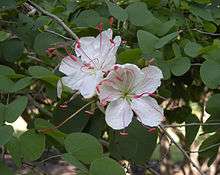Lysiphyllum
Lysiphyllum[2] is a genus of flowering plants in the legume family, subfamily Cercidoideae[3] and tribe Bauhinieae.[4] It belongs to the subfamily Cercidoideae. It was formerly treated as part of the genus Bauhinia, but recent molecular phylogenetic analysis confirms that Lysiphyllum is a distinct genus from Bauhinia.[4] [5][6][7][8]
| Lysiphyllum | |
|---|---|
 | |
| Lysiphyllum hookeri | |
| Scientific classification | |
| Kingdom: | Plantae |
| Clade: | Tracheophytes |
| Clade: | Angiosperms |
| Clade: | Eudicots |
| Clade: | Rosids |
| Order: | Fabales |
| Family: | Fabaceae |
| Tribe: | Bauhinieae |
| Genus: | Lysiphyllum (Benth.) de Wit |
| Type species | |
| Lysiphyllum cunninghamii (Benth.) de Wit | |
| Species | |
| Synonyms[1] | |
| |
Species
Lysiphyllum comprises the following species:[9][10][11]
- Lysiphyllum binatum (Blanco) de Wit
- Lysiphyllum carronii (F. Muell.) Pedley—Northern Beantree, Red Bauhinia
- Lysiphyllum cunninghamii (Benth.) de Wit
- Lysiphyllum diphyllum (Buch.-Ham.) de Wit
- Lysiphyllum gilvum (Bailey) Pedley
- Lysiphyllum hookeri (F. Muell.) Pedley—White Bauhinia, Pegunny, Mountain Ebony, Queensland Ebony, Hooker's Bauhinia
- Lysiphyllum strychnifolium (W. G. Craib) A. Schmitz
- Lysiphyllum winitii (Craib) de Wit
gollark: Also, if you want those first two, C.
gollark: Go isn't simple, though.
gollark: Did I mention that Go is bad?
gollark: With what de¢ompiłer?
gollark: And then run the C version of Lua, *inside emulated x86*.
References
- Wunderlin RP (2010). "Reorganization of the Cercideae (Fabaceae: Caesalpinioideae)" (PDF). Phytoneuron. 48: 1–5.
- de Wit HCD (1956) Reinwardtia 3: 431.
- The Legume Phylogeny Working Group (LPWG). (2017). "A new subfamily classification of the Leguminosae based on a taxonomically comprehensive phylogeny". Taxon. 66 (1): 44–77. doi:10.12705/661.3.
- Sinou C, Forest F, Lewis GP, Bruneau A (2009). "The genus Bauhinia s.l. (Leguminosae): a phylogeny based on the plastid trnL–trnF region". Botany. 87 (10): 947–960. doi:10.1139/B09-065.
- "Lysiphyllum". Legumes of the World. London, England: Royal Botanic Gardens, Kew. Archived from the original (Online, at kew.org) on 15 May 2014. Retrieved 14 May 2014.
- Bruneau A, Forest F, Herendeen PS, Klitgaard BB, Lewis GP (2001). "Phylogenetic Relationships in the Caesalpinioideae (Leguminosae) as Inferred from Chloroplast trnL Intron Sequences". Syst Bot. 26 (3): 487–514. doi:10.1043/0363-6445-26.3.487 (inactive 2020-05-21).
- Herendeen PS, Bruneau A, Lewis GP (2003). "Phylogenetic relationships in caesalpinioid legumes: a preliminary analysis based on morphological and molecular data". In Klitgaard BB, Bruneau A (eds.). Advances in Legume Systematics, Part 10: Higher Level Systematics. Royal Botanic Gardens, Kew. pp. 37–62. ISBN 978-1-84246-054-2.
- Bruneau A, Mercure M, Lewis GP, Herendeen PS (2008). "Phylogenetic patterns and diversification in the caesalpinioid legumes". Botany. 86 (7): 697–718. doi:10.1139/b08-058.
- "ILDIS LegumeWeb entry for Lysiphyllum". International Legume Database & Information Service. Cardiff School of Computer Science & Informatics. Retrieved 9 May 2014.
- USDA; ARS; National Genetic Resources Program. "GRIN species records of Lysiphyllum". Germplasm Resources Information Network—(GRIN) [Online Database]. National Germplasm Resources Laboratory, Beltsville, Maryland. Retrieved 9 May 2014.
- "The Plant List entry for Lysiphyllum". The Plant List. Royal Botanic Gardens, Kew and the Missouri Botanical Garden. 2013. Retrieved 9 May 2014.
This article is issued from Wikipedia. The text is licensed under Creative Commons - Attribution - Sharealike. Additional terms may apply for the media files.